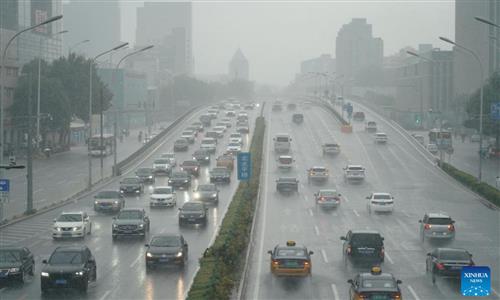Countries eye cooperation with China in meteorological technology to address climate change challenges

Lightning brightens the night sky over Washington, DC, during a rainstorm on April 20, 2015. Photo: CFP
Multiple countries are looking to cooperate with China in the field of meteorological technology to address the climate change challenges that have gripped countries around the world.
"Many countries, including Egypt, Jordan, Mauritania and Gulf countries, have great interest in cooperatively using China's meteorological technological products to jointly reduce disaster risks and improve multi-hazard early warning services," Xu Xiaofeng, the head of China Meteorological Service Association (CMSA), told the Global Times on Monday.
Xu said that extreme weather disasters are frequent around the world, with heat waves, rainstorms and hurricanes, droughts and floods sweeping across the planet.
From the end of December 2022 to March, California was hit by a strong storm and sustained heavy rainfall that has caused heavy losses. Entering the middle of July, a persistent heat wave lingered in Europe, and most Italian cities issued red alerts. Most recently, Middle Eastern countries were gripped by Medicane Daniel, which killed more than 10,000 people in Libya in early September.
China's Central Meteorological Observatory issued a red alert for heavy rain for the second time in 11 years as a record-breaking extreme rainstorm at the end of July triggered severe flooding in North China, which was plagued by high temperatures and little rain from June to July.
Xu told the Global Times that many Arab countries are showing interest in working with China on meteorology after the Meteorological High-quality Development Cooperation Forum was recently held in Northwest China's Ningxia Hui Autonomous Region as part of the China-Arab States Expo.
Meteorological cooperation between China and many Arab countries has great potential as China and the Middle East are on the same page when it comes to pledges to cut carbon emissions and achieve carbon neutrality, Xu noted, adding that many Arab countries are also showing interest in using renewable energy sources.
The use of cloud seeding technology from China and the lidar system for meteorological observation has particularly grabbed their attention, Xu said.
The application of new technology and the development of numerical forecasting are particularly critical against the backdrop of frequent extreme weather and climate events, a senior meteorological expert from Gulf Cooperation Council said.
Experts at the meeting also reached a consensus on promoting the use of China's meteorological satellite system Fengyun to jointly carry out disaster prevention and reduction, according to the China Meteorological Administration (CMA).
"The Fengyun meteorological satellites have provided all-weather and all-day remote sensing monitoring services to Arab countries, and play an important role in wildfire monitoring and other aspects," said the head of the ground observation system of the Moroccan Meteorological Service.
In 2018, the FY-2H satellite was moved westward by 7.5 degrees, to 79 degrees East, which is of vital significance to addressing data acquisition and application in geostationary meteorological satellites for countries involved in the "Belt and Road."
If countries in "Belt and Road" territories are hit by disasters such as typhoons, rainstorms, sandstorms, forest fires or prairie fires, they can apply to activate dedicated observation by Fengyun satellites, the CMA said. The number of countries and regions using Fengyun meteorological satellite data has reached 129.
Feng Yirong, director of the South China regional numerical forecasting center of the China Meteorological Administration, said that customized numerical forecasting model technology for countries taking part in the Belt and Road Initiative will be strengthened.
"The Silk Road built a bridge for economic and cultural communication, while international cooperation in meteorology is crucial to jointly reduce disaster risks and improve multi-disaster early warning services," Feng noted.




